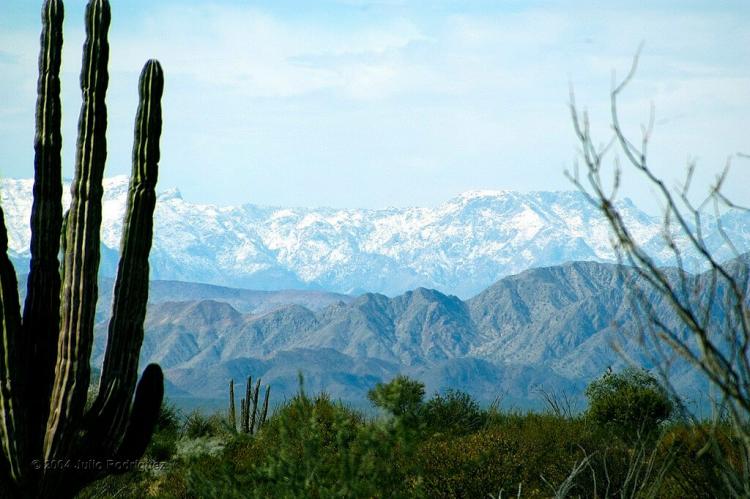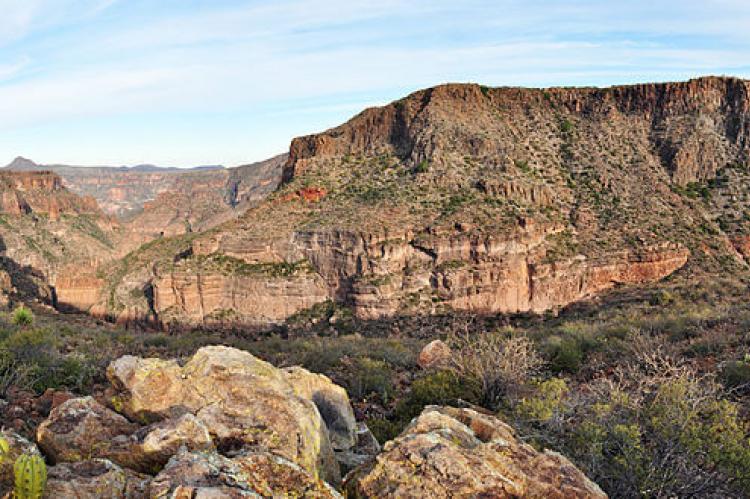Peninsular Ranges System: Tres Vírgenes Volcanic Complex (Mexico)
The Peninsular Ranges System is a series of six coastal mountain ranges running from north to south along the entire Baja California Peninsula in northwestern Mexico. The Tres Vírgenes volcanic complex contains the only stratovolcanoes on the peninsula.
Peninsular Ranges System
The Peninsular Ranges are a series of coastal mountain ranges running north to south along the entire Baja California Peninsula in northwestern Mexico.
The Peninsular Ranges System comprises six mountain ranges dominated by Mesozoic granitic rocks. They are part of the larger North American Coast Ranges located along the Pacific Coast, from Alaska to Mexico. The Pacific Coast Ranges are, in turn, part of the North American Cordillera.
The Peninsular Ranges stretch some 1,500 km (930 mi) from the border with Southern California to the peninsula's southern tip. Elevations range from approximately 150 - 3,300 m (500 - 10,800 ft).
Ecoregions present within the Peninsular Ranges System include desert, xeric shrubland and pine-oak forest. The pine-oak forests occur in the mountains at the northern and southern ends of the peninsula.

NASA topographic map of Baja California
Sierra de Juárez
The Sierra de Juárez is the northernmost range of the Peninsular Ranges System and of Mexico itself. The mountain range begins just south of the Laguna Mountains and the international border with California. From there, it extends southward approximately 140 km (87 mi).
The Sierra de Juáreze rises sharply from a desert valley in the east, but its eastern slope is gentler. The highest peak in the range rises to 1,980 m (6,500 ft) asl. Constitution 1857 National Park is a protected area located within the range.
The lower elevations of the western slopes of the Sierra de Juárez are in the California coastal sage and chaparral sub-ecoregion, while the lower elevations of the eastern slopes are in the Sonoran Desert ecoregion, with its unique desert flora.
The higher elevations of the Sierra de Juárez and those of the Sierra San Pedro Mártir are in the Sierra Juarez and San Pedro Martir pine-oak forests ecoregion. Sagebrush (Artemisia tridentata) is a common shrub of the understory.
Sierra de San Pedro Mártir
The Sierra de San Pedro Mártir is located south of the Sierra de Juárez and acts as a drainage divide between waters flowing west into the Pacific Ocean and east into the Gulf of California. As a result, snow can be found at the upper elevations in winter.
The highest peak in the range is Picacho del Diablo ('Devil's Peak'), also known as Cerro de la Encantada ('Enchanted Mountain') and Picacho la Providencia ('Providence Peak'). At 3,096 m (10,157 ft) asl, it is also the highest point in the Baja California Peninsula.
The Sierra de San Pedro Mártir National Park, known for its pine trees and granite rock formations, is located here. The National Astronomical Observatory is also found in the range, at an elevation of 2,830 m (9,280 ft) asl.
The coniferous forests of the Sierra de San Pedro and Sierra de Juárez Mártir comprise a Sky island: an elevated temperate forest surrounded by lower, more arid lands.
Sierra de San Borja
The Sierra de San Borja (also known as Sierra La Libertad) is located south of the Sierra de San Pedro Mártir and is the northernmost outpost of the Great Mural rock art of the central Baja California mountains. The highest point of the Sierra is Cerro La Sandia, at 1,775 m (5,823 ft) asl.
The Sierra de San Borja is nearly uninhabited. Desert vegetation prevails with only a few water sources. The mountain range does not capture enough precipitation to support the oak-pine forests of the higher and more humid mountain ranges in northern and southern Baja California.
The Sierra de San Borja is the northernmost outpost of the "Great Mural" rock art of the central Baja California mountains. Great mural rock Art consists of prehistoric paintings of humans and other animals, often larger than life-size, on the walls and ceilings of natural rock shelters.
Tourists visit the San Francisco Borja Mission (founded in 1762) and the extensive prehistoric rock art scattered throughout the mountains.
Sierra de San Francisco
The Sierra de San Francisco, situated north of San Ignacio, is the northernmost of a series of volcanic ranges running the length of the eastern side of Baja California Sur. Drained by many steep canyons, which harbor mesquite forests and palm groves, its rugged terrain makes access difficult.
The mountain range, along with the Tres Vírgenes volcanic complex and Sierra Guadalupe, forms the eastern edge of the Vizcaíno Desert and links the southern peninsula's tropical components with temperate influences of the north. The vegetation is of the Baja California Desert ecoregion.
The El Vizcaíno Biosphere Reserve encompasses the Sierra de San Francisco. Located within the mountains are the prehistoric rock art pictographs of the Cochimí people, also known as the Rock Paintings of Sierra de San Francisco, a UNESCO World Heritage site.
Sierra de la Giganta
The Sierra de la Giganta rises abruptly from the Gulf of California (Sea of Cortez) and parallel to the southeastern coast of the Baja California Peninsula in Baja California Sur state.
The highest point in the range is Cerro de la Giganta at 1,176 m (3,858 ft) asl, located near Loreto. The range is riddled with canyons and caves. The Tabor Canyon is a natural landmark formed within the Sierra La Giganta. It is known for its natural swimming pools and steep walls for climbing and abseiling.
Here are found the caves once inhabited by the Guaycura, the region's first settlers. Part of their heritage is preserved in the numerous petroglyphs and cave paintings.
The range is predominantly covered in dry (or xeric) shrubland. The Baja California Desert ecoregion covers the range's Pacific (western) slope, and the Gulf of California xeric scrub ecoregion covers the Gulf (eastern) slope.
Valley streams with year-round water sustain palm oases, with groves of the native Washingtonia robusta and other moisture-loving plants.
Sierra de la Laguna
The Sierra de la Laguna is located at the southern end of the Baja California Peninsula and is the southernmost range of the Peninsular Ranges System.
In prehistoric times, the Sierra de la Laguna was an island. As a result, it has a distinctive flora and fauna and is home to many endemic species and subspecies.
The dry San Lucan xeric scrub ecoregion extends from the sea level at the coast to 250 m (820 ft) in elevation. The Sierra de la Laguna dry forests ecoregion occupies a lower portion of the range, from 250 - 800 m (820 - 2,620 ft) in elevation.
Above 800 m (2,600 ft) asl, the dry forests transition to the Sierra de la Laguna pine-oak forests. The composition of the pine-oak forests varies with elevation. The predominant pine is a local subspecies of Mexican Pinyon, Pinus cembroides subsp. lagunae. The forests are exploited commercially for timber. Cattle raising is common in oak woodland and dry forest zones.
The Sierra La Laguna Biosphere Reserve was designated in 2003 to protect these temperate woodlands, dry forests and xeric shrublands, which constitute the most important reproduction site for the primary hummingbird species of Mexico and Latin America. Unfortunately, the area of the Biosphere Reserve also represents the least explored territory in Baja California Sur.

Map showing the Sierra de la Laguna Mountain Range
Tres Vírgenes Volcanic Complex
The Tres Vírgenes volcanic complex contains the only large stratovolcanoes on the Baja California Peninsula. It is part of a volcanic ridge that extends from Baja California towards the Guaymas Basin, a submarine depression in the Gulf of California.
The volcanic complex is located about 36 km (22 mi) northwest of the town of Santa Rosalía in the northeastern part of the state of Baja California Sur.
The Tres Vírgenes volcanic complex is composed of three volcanoes, aligned northeast to southwest:
-
El Viejo: the oldest, to the northeast, is made up of three lava domes
-
El Azufre: the next oldest, in the middle, has a central dome with pyroclastic fans
-
El Vírgen (or La Vírgen): the youngest, to the southwest, is the most conspicuous and complex, comprising at least six cones.












